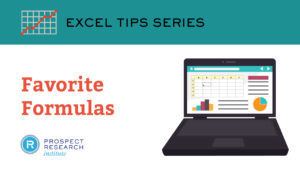 Two of the strongest characteristics prospect research professionals have in common is insatiable curiosity combined with a surprising boldness. We are proudly generalists! And very good at it too.
Two of the strongest characteristics prospect research professionals have in common is insatiable curiosity combined with a surprising boldness. We are proudly generalists! And very good at it too.
I was inspired by a visit to the Philadelphia Museum of Art in September where an APRA Pennsylvania member shared how she fearlessly tackled fundraising analytics to upgrade the organization’s major gift prospect pools.
Suzanne Harris is a Research Analyst and her supervisor is Sarah Cadbury, Director of Prospect Research and Management. A new researcher, in 2014 Suzanne was a successful student of the Prospect Research Institute’s inaugural Introduction to Prospect Profiles course. When she joined the Philadelphia Museum of Art she jumped right into a campaign and the prospect identification and tracking that goes along with that.
Sarah had created a campaign rating – the amount a specific prospect was anticipated to give – as a way of sorting and compiling the campaign gift table. They also had external vendor ratings, including a capacity rating from 2014. As discussions swirled around segmenting prospects effectively it became clear to Suzanne that a score based on internal data was needed.
At a previous organization Suzanne had read Joshua Birkholz’ book, Fundraising Analytics: Using Data to Guide Strategy, and had become interested in creating an RFM (Recency, Frequency, Monetary) score, but she hadn’t quite figured out how to adapt the book’s method to their constituency.
At the Philadelphia Museum of Art she was using the Raiser’s Edge donor database. Raiser’s Edge provided summary financial data, which was exactly what she needed to calculate RFM.
But still, Suzanne struggled with how to make it come together for the Museum. She began having conversations internally with database/IT folks. She emphasized how the RFM data would be used and why that was important.
She attended an APRA conference where she heard Joshua Birkholz talk about the value of fundraising analytics. Upon returning to the office she read her notes out loud, verbatim, to persuade people of the importance of a score like RFM.
Then, finally, it all came together in one meeting. Suzanne sat down for about an hour and half with an internal database guru and they worked out how the RFM could be automatically calculated using an intermediary Access database. They cherry-picked the data points most relevant to the Museum and created the scores based on them.
Suzanne’s “I can do anything” generalist attitude, combined with her ability to boldly persuade others of the importance of an internal score had resulted in success!
Marcy Serkin, Deputy Director of Development for Development Operations, suggested they roll out the RFM scores with a party. So they did. The party was an inclusive, all-staff party. People who had no idea of what ratings were learned about them. They threw the party on a Monday because the Museum is closed on Mondays and the gift officers are usually in the office.
Much like any other product launch party, they introduced RFM with a theme, fun activities, and education. Inspired by the art of Lisa Frank, they chose a colorful rainbow and unicorn theme.
Data Mining: Because Unicorns Don’t Find Themselves.
They created custom stickers and let people “taste the rainbow” with Skittles candy. They played a game, too, where everyone had cards with RFM scores. The last three people standing – the unicorns in the room – all had high scores and were not assigned to a gift officer. Their prize was a swipe at the unicorn piñata!
Suzanne is not a statistician or a data scientist. She is a prospect research professional. A generalist!
She used her prospect research knowledge to persuade others about the importance of internal scoring and to collaborate with her to create and launch the scoring so that it could have a positive impact on the campaign – and even beyond the campaign to annual fund and planned giving.
Suzanne is a prospect research hero! You can be, too. Be confident in your skills and boldly persuade others to use research effectively for fundraising.
More Resources You Might Like
Join the Resource Collections online community to access this video tutorial.
- Collection of Fundraising Analytics Articles | Stephen Lambert PhD | 2016
- Five ways to promote in-house data mining | Kevin MacDonell | 2010
- Data & Wolf Packs: 24 Months as a Data Analyst in Advancement | John P. Gough | 2016
- Are You Keeping Score? | Bentz Whaley Flessner | 2016

5 thoughts on “Warning! Anyone can do analytics.”
Comments are closed.